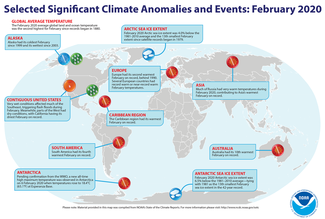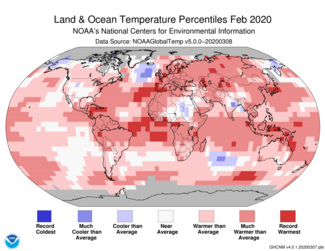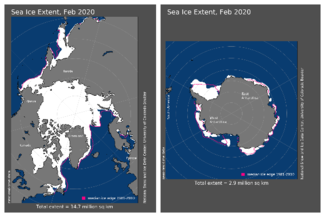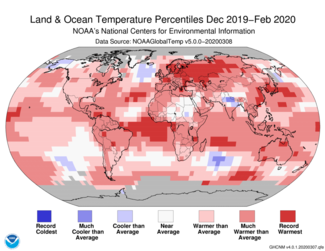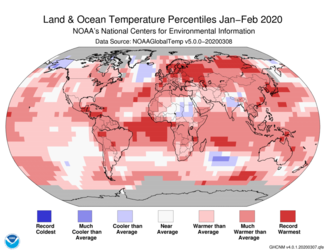Second warmest February and December–February for globe

The globally averaged temperature departure from average over land and ocean surfaces for February 2020 was the second highest for the month of February in the 141-year NOAA global temperature dataset record, which dates back to 1880.
This monthly summary, developed by scientists at NOAA National Centers for Environmental Information, is part of the suite of climate services NOAA provides to government, business, academia and the public to support informed decision-making.
February 2020 Temperature
The February 2020 global land and ocean surface temperature was 2.11°F (1.17°C) above the 20th century average of 53.8°F (12.1°C). This was the second highest for February in the 141-year record and was the third highest monthly temperature departure from average in the 1,682-month record. Only March 2016 and February 2016 had a higher temperature departure.
- February 2020 marked the 44th consecutive February and the 422nd consecutive month with temperatures, at least nominally, above the 20th century average.
- February 2016, 2017 and 2020 were the only Februarys with a global land and ocean surface temperature departure from average above 1.8°F (1.0°C). The 10 warmest Februarys have all occurred since 1998.
- According to NOAA’s Climate Prediction Center, ENSO neutral conditions continued across the tropical Pacific Ocean during February 2020. The February 2020 global land and ocean surface temperature departure from average was the highest monthly temperature departure without an El Niño present in the tropical Pacific Ocean, surpassing the previous record set last month (January 2020).
- The Northern Hemisphere also had its second warmest February on record, with a combined land and ocean surface temperature departure from average of 2.84°F (1.58°C), which was 0.13°F (0.07°C) shy of tying the record-warm February set in 2016.
- The Southern Hemisphere’s land and ocean surface temperature departure from average was 1.37°F (0.76°C) above average, tying with 2017 and 2019 as the second warmest February on record.
- The most notable warmer-than-average February 2020 temperatures were present across much of western and central Russia, parts of eastern Europe, and Kazakhstan, where temperatures were 9.0°F (5.0°C) above average or higher. The most notable cool temperature departures from average during February were observed across much of Alaska and parts of northern Canada and Far East Russia, with temperatures at least 5.4°F (3.0°C) below average.
- Record-warm February surface temperatures were present across parts of the Atlantic, Indian and western Pacific oceans, as well as parts of northern South America, Asia, Africa, and Europe. No land or ocean areas had record-cold February temperatures.
- Asia and the Caribbean region had their warmest February on record with temperatures at 7.36°F (4.09°C) and 1.96°F (1.09°C) above average, respectively. For the Caribbean region, this was the first time a February temperature was above 1.8°F (1.0°C) and tied with September 2005 as the ninth highest monthly temperature departure for any month in the 1,322-month record for the region. Asia had its second highest monthly temperature departure on record for any month, behind March 2008, and marked only the second time monthly temperature departures were above 7.2°F (4.0°C) on record.
Sea Ice and Snow Cover
Arctic daily sea ice growth during February 2020 was near the 1981–2010 average. Overall, the February average Arctic sea ice extent of 5.67 million square miles was 240,000 square miles (4.0 percent) below the 1981–2010 average and the 13th smallest February extent in the 42-year record, according to analysis by the National Snow and Ice Data Center (NSIDC) using data from NOAA and NASA. Below-average February sea ice extent was present across parts of the Barents and Kara Seas and eastern Greenland Sea.
Antarctic sea ice extent during February 2020 was also the 13th smallest (tied with 1981) since satellite records began in 1979 at 1.11 million square miles or 80,000 square miles (6.5 percent) below the 1981–2010 average. This was the highest February Antarctic sea ice extent since 2015.
According to data from NOAA and analyzed by the Rutgers Global Snow Lab, the Northern Hemisphere snow cover extent during February was 810,000 square miles below the 1981–2010 average and third smallest February snow cover extent in the 54-year period of record. The North American snow cover extent was the 16th smallest on record, while Eurasia had its third smallest February snow cover extent on record.
December 2019–February 2020
The seasonal global land and ocean surface temperature for December 2019–February 2020 was the second highest in the 141-year record, with a temperature departure from average of 2.02°F (1.12°C) above the 20th century average of 53.8°F (12.1°C). The three-month period of December 2015–February 2016 had a higher temperature departure at 2.12°F (1.18°C).
- The Northern Hemisphere and Southern Hemisphere had their second warmest December–February period on record. For both hemispheres, only December 2015–February 2016 was warmer.
- December 2019–February 2020 was record warm for Europe and Asia, while South America, Oceania, and the Caribbean and Hawaiian regions had their second warmest such period since regional records began in 1910.
- During the three-month period, temperature departures from average above 7.2°F (4.0°C) were prominent across much of western and central Russia, as well as parts of Europe. The most notable cooler-than-average temperatures of 3.6°F (2.0°C) below average or cooler were present across much of Alaska and parts of northwestern Canada.
- Record-warm temperatures during the season were observed across parts of Asia, Europe, Australia, South America and the Atlantic, western Pacific, and Indian oceans.
January–February 2020
The year-to-date global land and ocean surface temperature was also the second highest in the 141-year record at 2.09°F (1.16°C) above the 20th century average of 53.8°F (12.1°C). This value is only 0.05°F (0.03°C) less than the record set in 2016.
- The Northern Hemisphere had its warmest January–February period since global records began in 1880, surpassing the previous record set in 2016. The Southern Hemisphere had its second warmest such period on record, behind 2016.
- Europe and Asia had their warmest January–February period on record. The Caribbean region, South America, and Oceania had a January–February temperature that ranked among the three highest on record.
- Warmer-than-average temperatures engulfed much of the global land and ocean surface temperatures during the first two months of the year, with the most notable warm temperature departures across much of western Asia and Europe, where temperatures were at least 6.3°F (3.5°C) above average or higher. Meanwhile, the most notable cool temperature departures of −5.4°F (−3.0°C) were present across much of Alaska.
- Record warm January–February temperatures were present across parts of northern Asia, Europe, Central and South America, as well as the Atlantic, Indian, and western Pacific oceans.
- According to a statistical analysis done by NCEI scientists, the year 2020 is very likely to rank among the five warmest years on record.
For a more complete summary of climate conditions and events, see our February 2020 Global Climate Report.

